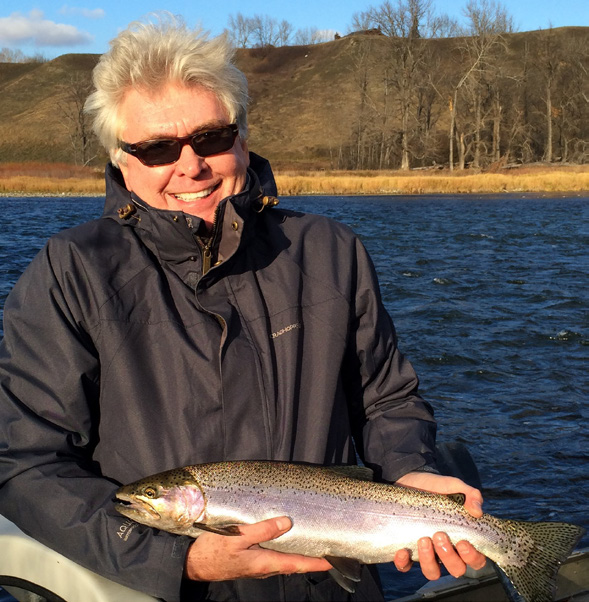John Reid is an intriguing fellow who grew up in Toronto but left for California as a college student and after an intense 30-year career in science and business – living in Switzerland, Korea, and both coasts of the US – he returned to Canada six years ago and now lives on Church Street in downtown Stouffville. John is semi-retired and operates a consulting company (TalkingTerms) focused on helping biotechnology companies develop medical innovations and secure the capital they need to develop their products. But as John would say, “Truth is, my wife, Magdalena is more interesting than me and her leadership in the world of Ikebana, the Japanese art of flower arranging, brings joy to hundreds of people worldwide”.
Why live in Stouffville? “Farms, Fish and Forests,” he said. You may be surprised by the simplicity of this reasoning, as John’s professional life is far from simple, but for him it makes sense to be able to work from home and have ready access to the forests and farms where he can enjoy fishing and walking the trails. It also completes a career journey, which took him from winemaking to biotechnology, drug discovery, and business development, to a place where he can help people start biotech companies based on world-class health science research in Canada.
John was born in Toronto and spent the first few years of life living in a derelict coach house on the U of T campus (since demolished), while his father was studying law and his mother worked at the Toronto General Hospital on College Street, which later became the MaRS Discovery District. Many years later, John returned to the MaRS building as Director of Technology Development and Commercialization at UHN and proudly kept a painting of the old coach house in his office.
As a teenager, after listening to his bon vivant uncle (a hotelier) talk enthusiastically about food and wine, John started to make wine at home. He found a summer job at a local winery and laid plans to write a guidebook to help people to buy wine intelligently and understand the labels, but first spent a few months in Europe on a shoe-string budget studying the great vineyards of France, Germany, Italy and Spain. His Guidebook to the LCBO was published by Toronto Life in 1975 when he was 24 years old, followed by Guidebooks in British Columbia and Alberta. At that time there was very little information about wines and their sources for consumers in Canada.
As many aspiring winemakers, John moved to California to attend the University of California at Davis, the agriculture campus of the UC system and a center for research on wine and grapes. John loved living in Davis, where he thrived as a student and grew as a person in his understanding of individual empowerment. In his spare time, he made wines from vineyards in Napa, Sonoma and the Sierra Foothills, which were as good as any he had tasted in Europe. Davis was also a hotspot for the emerging science of biotechnology, which was poised to create a revolution in medicine, and John decided to put winemaking on hold, while he got into genetic engineering at Genentech and completed his PhD in Biology at UC Berkeley. He moved to Palo Alto to continue his genetic research and continued to make wine with a small group of friends under the name of “John’s Garage.” The big earthquake of ’97 spilled a lot of his wine but the few barrels that survived were labelled “Shaken, not Broken” and had many fans in the Bay Area. This wine was drunk at their wedding.
As a scientist, he moved to Switzerland as head of a laboratory at the Glaxo Institute, to discover new genes involved in diseases and worked with an international group of scientists on the massive international genome sequencing initiative. John and his wife loved living in Geneva, where they enjoyed skiing and hiking in the mountains. They lived close enough to France for John to make wine from a vineyard in Burgundy. After their daughter was born, they returned to North America in 1997, as head of drug discovery research to treat Alzheimer’s disease at AstraZeneca in Massachusetts and later Delaware, where he became the global director of alliance management and strategic partnerships for AstraZeneca’s neuroscience group. Simultaneously, he studied business administration and completed his M.B.A. in 2009. After he retired from Astra Zeneca, he moved to Seoul as a consultant to the South Korean Ministry of Health and several Korean biotech companies.
Shortly, thereafter, he was recruited by the University Health Network (UHN) in 2014 to lead the team that was responsible for the commercialization of medical discoveries made by UHN’s researchers and clinicians. The UHN position was very challenging but very successful. John and his team helped to launch some of the most successful biotech companies in Canada which have since provided benefits and revenues to help fund research at UHN for many years to come.
After renting a house in Toronto for a few years, he and Magdalena moved to Stouffville two years ago, which they found charming and friendly. Magdalena also had friends here who shared her passion for Ikebana. After John retired from UHN early this year, he started Talking Terms, which keeps him busy consulting for exiting new biotech companies. But for the first time in several years he again has time for his winemaking hobby. He is impressed with the high quality of apples in this region and has started a batch of organic apple wine from old heritage apple varieties growing near Goodwood. Will this become the next cult wine from “John’s Garage”? Stay tuned.
